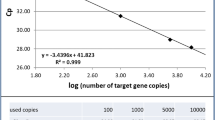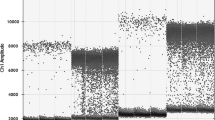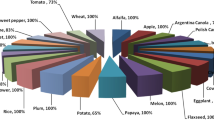Abstract
Simple tools to detect the presence of genetically modified organisms (GMO) in commercial products represent a valuable aid in managing the legal requirements for GMO testing in a cost-effective way. The “Real-Time PCR-Based Ready-to-Use Multi-Target Analytical System for GMO Detection” was developed to meet such requirements and was here further tested for its applicability on detecting GMO in recalcitrant maize matrices. Sixty-four processed maize products were purchased from the market of the European Union and analyzed for their GMO content. Seventy-five percent of the test samples were positive for the presence of GMO. In two samples, trace amounts of the so-called asynchronously authorized GMO could be detected. The overall outcome of the analyses indicated that most of the commercially available genetically modified maize events for food use could be detected in this study. Finally, the possibility to use the “Real-Time PCR-Based Ready-to-Use Multi-Target Analytical System for GMO Detection” in detecting GMO at a 0.1% mass level is documented. The implications of these results on the further development of such type of PCR-based GMO detection systems are discussed.


Similar content being viewed by others
References
Querci M, Van den Bulcke M, Žel J, Van den Eede G, Broll H (2010) New approaches in GMO detection. Anal Bioanal Chem 396:1991–2002
Miraglia M, Berdal KG, Brera C, Corbisier P, Holst-Jensen A, Kok E, Marvin HJP, Schimmel H, Rentsch J, van Rie JP, Zagon J (2004) Detection and traceability of genetically modified organisms in the food production chain. Food Chem Toxicol 42:1157–1180
Rodríguez-Lázaro D, Lombard B, Smith H, Rzezutka A, D’Agostino M, Helmuth R, Schroeter A, Malorny B, Miko A, Guerra B, Davison J, Kobilinsky A, Hernández M, Bertheau Y, Cook N (2007) Trends in analytical methodology in food safety and quality: monitoring microorganisms and genetically modified organisms. Trends Food Sci Technol 18:306–319
European Commission (2003) Regulation (EC) No 1829/2003 of the European parliament and of the council of 22 September 2003 on genetically modified food and feed. Off J Eur Union L 268:1–23
Foti N, Onori R, Donnarumma E, De Santis B, Miraglia M (2006) Real-time PCR multiplex method for the quantification of roundup ready soybean in raw material and processed food. Eur Food Res Technol 222:209–216
ENGL (2008) Definition of minimum performance requirements for analytical methods of GMO testing (2008) European Network of GMO Laboratories (ENGL). http://gmo-crl.jrc.ec.europa.eu/guidancedocs.htm
Van den Eede G (2010) Compendium of reference methods for GMO analyses. http://publications.jrc.ec.europa.eu/repository/handle/111111111/15068
Querci M, Foti N, Bogni A, Kluga L, Broll H, Van den Eede G (2009) Real-time PCR-based ready-to-use multi-target analytical system for GMO detection. Food Anal Methods 2:325–336
James C (2009) ISAAA brief 41-2009: global status of commercialized biotech/GM Crops: 2009. http://www.isaaa.org/resources/publications/briefs/41/executivesummary/default.asp
EU register of genetically modified food and feed. http://ec.europa.eu/food/dyna/gm_register/index_en.cfm
European Union reference laboratory for GM food and feed. CRL assessment on the validation of an event specific method for the relative quantitation of maize line MON 810 DNA using real-time PCR as carried out by Federal Institute for Risk Assessment (BfR). http://gmo-crl.jrc.ec.europa.eu/summaries/Mon810_validation_report.pdf
ISO (2005) International Standard 21571, foodstuffs—methods of analysis for the detection of genetically modified organisms and derived products—nucleic acid extraction. (Annex A.3) 2005; International Organization for Standardization, Geneva, Switzerland
Žel J, Mazzara M, Savini C, Cordeil S, Camloh M, Štebih D, Cankar K, Grudem K, Morisset D, Van den Eede G (2008) Method validation and quality management in the flexible scope of accreditation: an example of laboratories testing for genetically modified organisms. Food Anal Methods 1:61–72
Kluga L, Van den Bulcke M, Folloni S, Gineste JM, Weber T, Foti N, Mazzara M, Van den Eede G and Querci M (2011) A ready-to-use multi-target analytical system for GM soy and maize detection for enforcement laboratories. In: Tzi-Bun Ng (eds) Soybean—applications and technology. InTech Open Access Publisher, Rijeka, pp 173–184
Engel KH, Moreano F, Ehlert A, Busch U (2006) Quantification of DNA from genetically modified organisms in composite and processed foods. Trends Food Sci Technol 17:490–497
Cankar K, Štebih D, Dreo T, Žel J, Gruden K (2006) Critical points of DNA quantification by real-time PCR–effects of DNA extraction method and sample matrix on quantification of genetically modified organisms. BMC Biotechnol 6:37
Bellocchi G, De Giacomo M, Foti N, Mazzara M, Palmaccio E, Savini C, Di Domenicantonio C, Onori R, Van den Eede G (2010) Testing the interaction between analytical modules: an example with roundup ready soybean line GTS 40–3-2. BMC Biotechnol 10:55
European Commission (2000) Directive (EC) 2000/13/EC of the European parliament and of the council of 20 March 2000 on the approximation of the laws of the member states relating to the labelling, presentation and advertising of foodstuffs. Official J Eur Commun L109:29–42
European Commission (2003) Directive (EC) 2003/89/EC of the European parliament and of the council of 10 November 2003 amending directive 2000/13/EC as regards indication of the ingredients present in foodstuffs. Official J Eur Union L308:15–18
Barbau-Piednoir E, Lievens A, Mbongolo Mbella EG, Roosens N, Sneyers M, Leunda-Casi A, Van den Bulcke M (2010) SYBR_Green qPCR screening methods for the presence of ‘‘35S promoter’’ and ‘‘NOS terminator’’ elements in food and feed products. Eur Food Res Technol 230:383–393
Van den Bulcke M, Lievens A, Barbau-Piednoir E, Mbongolo Mbella EG, Roosens N, Sneyers M, Leunda Casi A (2010) A theoretical introduction to ‘‘combinatory SYBR_Green qPCR screening’’, a matrix-based approach for the detection of materials derived from genetically modified plants. Anal Bioanal Chem 396:2113–2123
Waiblinger H-U, Grohmann L, Mankertz J, Engelbert D, Pietsch K (2010) A practical approach to screen for authorized and unauthorized genetically modified plants. Anal Bioanal Chem 396:2065–2072
European Food Safety Authority (2009) Scientific opinion: application (reference EFSA-GMO-CZ-2005-27) for the placing on the market of the insect-resistant and herbicide-tolerant genetically modified maize MON88017, for food and feed uses, import and processing under regulation (EC) No 1829/2003 from Monsanto. EFSA J 1075:1–28. http://www.efsa.europa.eu/en/efsajournal/doc/1075.pdf
European Union reference laboratory for GM food and feed. Event-specific method for the quantification of maize line MON 88017 using real-time PCR. http://gmo-crl.jrc.ec.europa.eu/summaries/MON88017_validated_Method_correctedversion1.pdf
Greiner R, Konietzny U, Villavicencio ALCH (2005) Qualitative and quantitative detection of genetically modified maize and soy in processed foods sold commercially in Brazil by PCR-based methods. Food Control 16:753–759
Monma K, Araki R, Sagi N, Satoh M, Ichikawa H, Satoh K, Tobe T, Kamata K, Hino A, Saito K (2005) Detection of genetically modified organisms in foreign-made processed foods containing corn and potato. J Food Hyg Soc Jpn 46:79–85
Brandon C (2008) Genetic modification in organic corn products: are the labelling laws being followed? http://www.capital.edu/23615.pdf
Genetically modified maize in maize products (2002) Joint campaign by the state laboratories of Aargau, Basel Country, Basel City, Berne and Soleure. http://www.kantonslabor-bs.ch/files/berichte/Report52.pdf
Food Safety Authority of Ireland (2001) Survey of tortilla chips and taco shells for genetically modified ingredients. http://www.fsai.ie/uploadedFiles/tortilla_survey.pdf
Querci M, Kleter G, Malingreau J-P, Broll H, Van den Eede G (2008) Scientific and technical contribution to the development of an averall health strategy in the area of GMOs. JRC reference reports. EUR 23542 EN
Novak PK, Gruden K, Morisset D, Lavrac N, Stebih D, Rotter A, Zel J (2009) GMOtrack: generator of cost-effective GMO testing strategies. J AOAC Int 92:1739–1746
European Commission (2003) Regulation (EC) No 1830/2003 of the European parliament and of the council of 22 September 2003 concerning the traceability and labelling of genetically modified organisms and the traceability of food and feed products produced from genetically modified organisms and amending directive 2001/18/EC. Off J Eur Union L268:24–28
Cankar K, Chauvency-Ancel V, Fortabat MN, Gruden K, Kobilinsky A, Zel J, Bertheau Y (2008) Detection of nonauthorized genetically modified organisms using differential quantitative polymerase chain reaction: application to 35S in maize. Anal Biochem 376:189–199
Commission Regulation (EU) (2011) No 619/2011 of 24 June laying down the methods of sampling and analysis for the official control of feed as regards presence of genetically modified material for which an authorization procedure is pending or the authorization of which has expired. Off J Eur Union L166:9–15
Author information
Authors and Affiliations
Corresponding author
Rights and permissions
About this article
Cite this article
Kluga, L., Folloni, S., Van den Bulcke, M. et al. Applicability of the “Real-Time PCR-Based Ready-to-Use Multi-Target Analytical System for GMO Detection” in processed maize matrices. Eur Food Res Technol 234, 109–118 (2012). https://doi.org/10.1007/s00217-011-1615-5
Received:
Revised:
Accepted:
Published:
Issue Date:
DOI: https://doi.org/10.1007/s00217-011-1615-5




